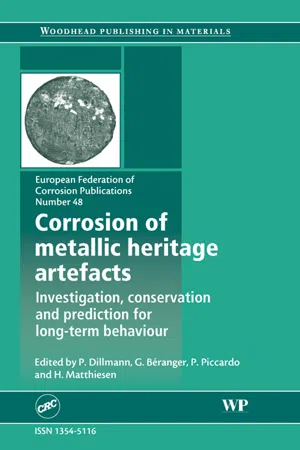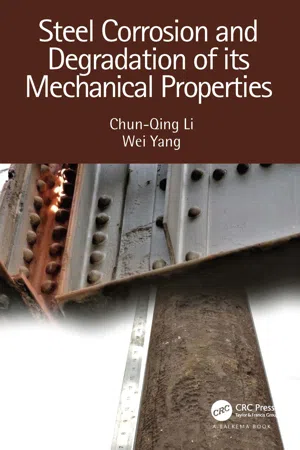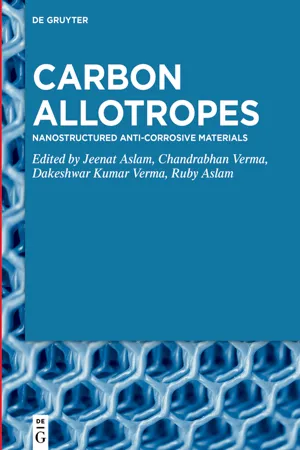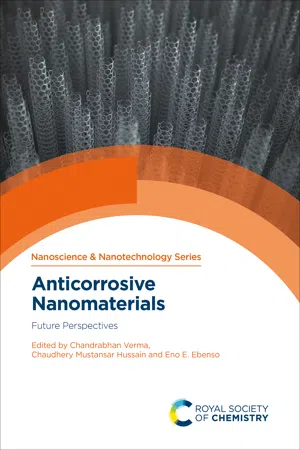Technology & Engineering
Iron Rust
Iron rust is a reddish-brown compound that forms on the surface of iron or steel when it comes into contact with oxygen and moisture. This process, known as corrosion, weakens the metal and can lead to structural damage. Preventative measures such as coatings, galvanization, or alloying are commonly used to protect iron and steel from rusting.
Written by Perlego with AI-assistance
Related key terms
Related key terms
1 of 4
Related key terms
1 of 3
5 Key excerpts on "Iron Rust"
- eBook - ePub
Corrosion of Metallic Heritage Artefacts
Investigation, Conservation and Prediction of Long Term Behaviour
- P Dillmann, G Beranger, P Piccardo, H Matthiessen(Authors)
- 2014(Publication Date)
- Woodhead Publishing(Publisher)
2 ] to acquire more relevant and robust prediction of corrosion behaviour of materials. In order to get reliable experimental values of damage rates associated with a well-known wet–dry cycle, old rusted historical artefacts and low-alloy steel samples have been introduced in a climatic chamber for ageing tests. It is essential to determine such values in order to validate the modelling calculations and assumptions. Then, the experimental and calculated values are compared.The atmospheric corrosion of iron is an electrochemical process occurring in the presence of an electrolyte. The corrosion of iron can be summarized by the following chemical equation:8.2 Atmospheric corrosion of iron
8.2.1 Description
4(8.1)Fe + 3O2O = 4FeOOH+ 2H2(8.1)The oxidation of iron by dissolved oxygen in thin electrolyte film leads to the formation of a rust layer composed of various oxides and oxy-hydroxides. By taking into account the fact that corrosion will occur away from atmospheric precipitation, the formation of the electrolyte film will be due to condensation of water from the atmosphere. This condensation depends mainly on the temperature and the relative humidity (RH) of the atmosphere. It is generally considered that corrosion phenomena start when relative humidity is higher than 60% and become more important when RH reaches 80% [3 ]. The variations of temperature and RH (due, for example, to the changeover between night and day) will create a succession of wet (with water condensing on the container walls) and dry cycles. Figure 8.1 shows the measurements of the variations of iron corrosion and oxygen consumption rates as experimentally measured by Stratmann [4 ]. Three different stages can be observed in Fig. 8.1 ; the wetting stage, the wet stage and the drying stage. Each of these stages is characterized by different physico-chemical mechanisms.8.1 The wet–dry cycle. Variations of iron (dotted line) and oxygen (solid line) consumption rates as experimentally measured by Stratmann [4 - Chun-Qing Li, Wei Yang(Authors)
- 2021(Publication Date)
- CRC Press(Publisher)
The complexation is however much more in details of the chemical process rather than in principle. Since the most commonly exposed environment for steel structures is mainly atmosphere, and that for cast iron is soil (such as underground pipes), this book focusses more on the atmospheric corrosion for steel and corrosion in soil for cast iron and ductile iron. Furthermore, this book is intended for engineers for assessing corrosion-induced damages to steel and steel structures; fundamentals of corrosion science and chemical reactions will not be presented in detail here since they can be easily found in other books, such as Revie and Uhlig (2008) and Marcus (2011). 2.2.1 Electrochemical reactions In essence, steel corrosion is an electrochemical process that occurs when two or more points on the steel surface have a potential difference, and two chemical reactions, i.e., oxidation and reduction, take place simultaneously on the steel surface (Cramer and Covino 2003). The process of steel corrosion involves four basic parts: A metal, which acts as an electrical conductor for anodic and cathodic electronic transfer; An anode, where electrochemical oxidation takes place and electrons are liberated; A cathode, where electrochemical reduction occurs, and electrons transferred from the anode are consumed; A conductive medium, which is the aqueous medium or electrolyte or the local environment the steel is exposed to. The oxidation reaction is also known as anodic reaction, in which electrons are lost, resulting in a non-metallic state. Anode is the point where electrons on the steel surface are lost and corrosion takes place. The oxidation reaction can be expressed as follows (Revie and Uhlig 2008): Fe → Fe 2 + + 2 e − (2.1) The reduction reaction is known as cathodic reaction, which balances the anodic reaction. In this reaction, ions in the electrolyte accept electrons that are released from the electrically connected anode- eBook - ePub
- David E.J. Talbot, James D.R. Talbot(Authors)
- 2018(Publication Date)
- CRC Press(Publisher)
Section 3.2.6.2 .7.2.3Rusting in AirRusting of bare iron and steel surfaces is generally slower in outside air than in water but is much more variable, ranging from near zero to over 0.1 mm per year and it is less predictable. The factors that influence it differ from location to location and vary with time. They include climate, season and weather, atmospheric pollutants, temperature cycles and the initial conditions and orientations of the iron or steel surfaces. There are so many independent variables that empirical comparisons between the results of limited field tests can be unreliable and the effort to acquire statistically significant information is protracted because rates of rusting can take several years to settle to steady values. More progress can be made by applying scientific principles and logic to interpret accumulated local experience.There are three sources of water to sustain the electrochemical processes in air, atmospheric humidity, precipitation and wind- or wave-driven spray. 7.2.3.1Rusting Due to Atmospheric HumidityRust can form on iron even when it is not wet to the touch. It is less in dry than in humid air and more in industrial or marine locations than in rural areas. These observations are rationalized on the basis of Evans* and his colleagues’ classic experiments to clarify the effects of relative humidity and pollutants on rusting. Iron samples do not rust appreciably in pure clean air even when nearly saturated with water vapour, but if as little as 0.01% by volume of sulfur dioxide is present as a pollutant, the metal rusts rapidly when the relative humidity exceeds a threshold value of about 70%. Dust contaminated with certain ionic salts has a similar effect in initiating rusting. Evans proposed a simple but elegant explanation as follows. An aqueous electrolyte is needed to produce rust and although water cannot condense spontaneously from unsaturated air, it can be induced to do so by hygroscopic salts. The role of pollutants is to provide particles of such salts on the metal surface. If the pollutant is sulfur dioxide, as it is in industrial locations, the salt is Fe(II) sulfate, FeSO4 - eBook - ePub
Carbon Allotropes
Nanostructured Anti-Corrosive Materials
- Jeenat Aslam, Chandrabhan Verma, Dakeshwar Kumar Verma, Ruby Aslam(Authors)
- 2022(Publication Date)
- De Gruyter(Publisher)
Chapter 3 Corrosion: basics, economic adverse effects, and its mitigationSourav Kr. Saha ✶Namhyun Kang ✶Abstract
Corrosion is a natural phenomenon. As all the natural processes have the tendency to attain lowest energy state, iron or steel also combines with other chemical elements in order to return to their lowest energy state. To return to lowest energy state, iron or steel always combines with oxygen and water present in the environment and forms hydrated iron oxide (rust), which has similar composition to the iron ore. The major reason for concerning about the corrosion is economy, safety, and conservation. Due to corrosion, huge amount of economic loss as well as causalities occur worldwide. According to the report, the annual cost of corrosion in the United States was US $276 billion which is equivalent to 3.1% of the US gross domestic product. Therefore, it is very essential to minimize the corrosion to save considerable expenses in equipment, structure, and materials. This chapter provides a brief overview about corrosion and its adverse effects related to the economy and safety. Additionally, proper methods to mitigate corrosion were also discussed in detail.Keywords: Corrosion, Effect of corrosion, Corrosion cost, Corrosion inhibition,3.1 Introduction
“Corrosion” means rust, and it is the universal object of hatred. Rust is more specifically reserved for the corrosion of irons. Although almost all metals and their alloys face corrosion-related problems, corrosion is an undesirable phenomenon which can be defined as the “destruction or deterioration of a material due to its reactions with the environment.” The three major reasons for concerning about the corrosion are economics, safety, and conservation. In any developed country, economy and safety are directly related to corrosion. Corrosion of metals creates negative impact on the overall growth of the economy and may also cause tragic accident resulting in human injury or even loss of life [1 , 2 , 3 , 4 , 5 ]. In 2002, the United States Federal Highway Administration (FHWA) published a report associated with the metallic corrosion in a wide range of industries [6 ]. The results suggest that the total annual cost of corrosion in the USA was US $276 billion which is equivalent to 3.1% of the US gross domestic product (GDP). An article recently published in the Times of India reported that India loses wealth of approximately Rs 2 lakh crores per year due to corrosion [7 ]. The survey conducted by the Corrosion Science Society of Korea suggested that corrosion-related cost is around 2.9% of the Korean GDP (2005) [8 - eBook - ePub
Anticorrosive Nanomaterials
Future Perspectives
- Chandrabhan Verma, Chaudhery Mustansar Hussain, Eno Ebenso(Authors)
- 2022(Publication Date)
- Royal Society of Chemistry(Publisher)
Chapter 8 Anti-corrosive Applications of Iron, Copper and Titanium OxidesRUBY ASLAMa , MOHAMMAD MOBINa , SAMAN ZEHRAa , CHANDRABHAN VERMA,b AND JEENAT ASLAM,ca Corrosion Research Laboratory, Department of Applied Chemistry, Faculty of, Engineering and Technology, Aligarh Muslim University, Aligarh 202002, India;b Interdisciplinary Research Centre for Advanced Materials, King Fahd University of Petroleum and Minerals, Dhahran 31261, Saudi Arabia;c Department of Chemistry, College of Science, Taibah University Yanbu-30799, Al-Madina, Saudi Arabia[email protected] ; [email protected]8.1 Introduction
Corrosion is an irreversible deterioration of materials and an expensive phenomenon being one of the significant issues occurring on Earth. There are numerous factors for a material's corrosion, such as operational characteristics, environmental situation, non-equilibrium phases, the ineffectiveness of protective films, or categories of materials used as a protective film. Moreover, the mechanism of an electrochemical reaction involved in the corrosion procedure, diverse atmospheres with operational circumstances, namely temperature, pressure, or humidity, affect the rate of corrosion to a large extent depending upon the materials involved.1 ,2Inhibitors, protective coatings, cathodic/anodic protection, electroplating, painting, and lubricating techniques can all be used to combat metal degradation. Chemists have proposed alternate corrosion inhibitors to gradually phase out harmful hexavalent chromates’ usage in response to the requirement.Metal elements can combine to generate a wide range of oxide compounds. These can have a wide range of structural geometries and an electrical structure that can be metallic, semiconducting, or insulating in nature. Metal oxides are a fascinating group of materials that are now being studied extensively. They have unusual mechanical stress tolerance, excellent optical transparency, extraordinary carrier mobilities, and magnetic characteristics controlled by particle size and shape.3 Oxides are employed in constructing microelectronic circuits, sensors, piezoelectric devices, fuel cells, corrosion-resistant coatings, and catalysts in technological applications. Oxide systems are considered superb protective films due to their significant stability and ability to serve as diffusion barriers for various reacting ionic species.4 ,5
Index pages curate the most relevant extracts from our library of academic textbooks. They’ve been created using an in-house natural language model (NLM), each adding context and meaning to key research topics.
Explore more topic indexes
Explore more topic indexes
1 of 6
Explore more topic indexes
1 of 4




